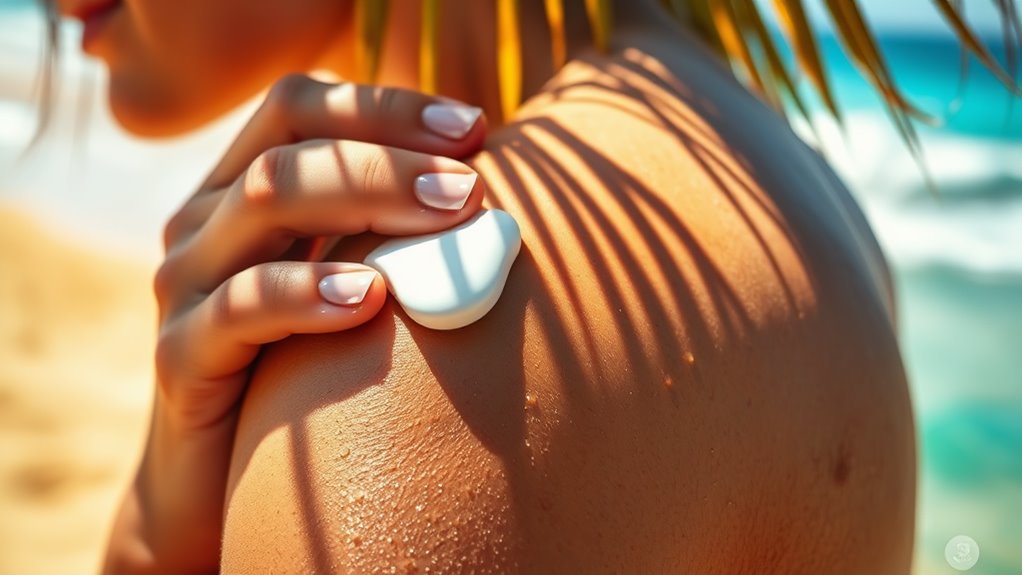Is Your Sunscreen Working. How to Make Sure You’re Protected
You might think applying sunscreen is enough to protect your skin, but are you sure it’s working effectively? Many factors come into play, from the SPF level to your application technique. If you want to guarantee you’re truly shielded from harmful UV rays, it’s essential to assess your sunscreen habits. Let’s explore how you can verify your sunscreen is doing its job and what additional steps you should consider for maximum protection.
Key Takeaways
- Check the expiration date of your sunscreen to ensure it remains effective and safe to use.
- Apply at least one ounce of sunscreen to cover all exposed skin thoroughly.
- Reapply sunscreen every two hours, or more frequently if swimming or sweating.
- Test compatibility with your skin by conducting a patch test on a small area.
- Look for broad-spectrum formulas to ensure protection against both UVB and UVA rays.
Understanding SPF and Broad-Spectrum Protection
Have you ever wondered what those SPF numbers on your sunscreen really mean? SPF, or Sun Protection Factor, indicates how well your sunscreen protects against UVB rays, which cause sunburn and contribute to skin cancer.
For instance, an SPF of 30 blocks about 97% of UVB rays, while SPF 50 blocks around 98%. However, no sunscreen offers 100% protection.
To maximize your protection, follow these sunscreen tips: apply a generous amount—about one ounce for full-body coverage—at least 15 minutes before sun exposure.
Reapply every two hours, or more often if swimming or sweating. Also, look for broad-spectrum protection, which safeguards against both UVB and UVA rays, ensuring thorough defense against sun damage.
Master these principles for effective sun protection.
Choosing the Right Sunscreen for Your Skin Type
Selecting the right sunscreen for your skin type can greatly enhance your sun protection strategy.
If you have oily or acne-prone skin, opt for a lightweight, oil-free formula that won’t clog your pores.
For dry skin, look for creams with added moisturizers or hydrating ingredients like hyaluronic acid.
If you’re sensitive or prone to irritation, choose mineral-based sunscreens containing zinc oxide or titanium dioxide, as they’re gentler.
Those with combination skin should consider a versatile lotion that balances oil and moisture.
Finally, if you have darker skin, remember that while you may have some natural protection, using a broad-spectrum sunscreen is still essential.
Tailoring your choice to your skin type guarantees peak protection and a comfortable experience outdoors.
The Importance of Proper Application Techniques
Applying sunscreen properly is just as essential as choosing the right product.
You need to apply it generously to cover all exposed skin and reapply it regularly, especially after swimming or sweating.
Skipping these steps can leave your skin unprotected, no matter how good your sunscreen is.
Apply Generously
To guarantee your sunscreen provides the maximum protection, it’s essential to apply it generously. Many people skimp on sunscreen, leaving vulnerable areas exposed. Aim for about one ounce, or a shot glass full, to cover your entire body effectively.
| Application Area | Recommended Amount | Tips |
|---|---|---|
| Face and Neck | 1 teaspoon | Don’t forget your ears! |
| Arms and Shoulders | 1 tablespoon | Cover both sides evenly. |
| Legs and Feet | 2 tablespoons | Verify toes and ankles are included. |
Reapply Regularly
Even with generous application, sunscreen loses its effectiveness over time, making reapplication essential for ongoing protection. Aim to reapply every two hours, or more frequently if you’re swimming or sweating.
Use a broad-spectrum sunscreen with at least SPF 30, ensuring you’re shielded against both UVA and UVB rays. When you reapply, don’t skimp—apply a full shot glass worth for your entire body.
Pay extra attention to areas often missed, like your ears, neck, and the tops of your feet. Consider using a spray or powder sunscreen for convenience, but always follow up with a cream-based product for thorough coverage.
Timing Your Sunscreen Application for Maximum Efficacy
How early should you apply sunscreen to guarantee it’s working effectively? Ideally, you should apply your sunscreen about 15 to 30 minutes before heading outdoors. This allows the active ingredients to bond with your skin, ensuring maximum protection when you’re exposed to UV rays.
Don’t forget to cover all areas, including often-missed spots like your ears, neck, and the tops of your feet. If you’re using a spray sunscreen, remember to apply it generously and rub it in to avoid missed patches.
Consistency is key, so make it a habit to apply sunscreen every morning, even on cloudy days. Taking these steps will enhance your skin’s defense, keeping it safe from harmful sun damage.
How to Test if Your Sunscreen Is Effective
To guarantee your sunscreen’s effectiveness, start by checking its expiration date.
Next, conduct a patch test to see how your skin reacts, and don’t forget to assess your application technique.
These simple steps can help you maximize your sun protection.
Check Expiration Date
Have you ever checked the expiration date on your sunscreen? It’s essential for ensuring your skin gets the protection it needs. Sunscreen ingredients can degrade over time, losing their effectiveness. Always look for the expiration date on the bottle; if it’s expired, toss it out. Here’s a quick guide to understanding expiration dates:
| Expiration Status | Action Required |
|---|---|
| Expired | Discard immediately |
| Unopened | Good for 3 years |
| Opened | Use within 1-3 years |
| No Date | Discard after 3 years |
Conduct Patch Test
Before slathering on sunscreen for a day in the sun, it’s a good idea to conduct a patch test to guarantee it’s effective and suitable for your skin.
Start by applying a small amount of sunscreen to a discreet area, like your inner forearm. Leave it on for 24 hours and observe for any reactions such as redness, itching, or irritation.
This test helps you identify if the formula is compatible with your skin type and minimizes the risk of adverse effects during sun exposure. If you notice any negative reactions, it’s best to try a different product.
Assess Application Technique
While you may have found a sunscreen that suits your skin, how you apply it plays an essential role in its effectiveness. To guarantee maximum protection, start by applying enough product—about a shot glass full for your entire body.
Make sure you cover all exposed areas, including often-missed spots like your ears, back of the neck, and tops of your feet. Rub the sunscreen in thoroughly to prevent uneven application.
Wait at least 15 minutes before stepping outside to allow the ingredients to bind effectively. If you’re in water or sweating, reapply every two hours or immediately after towel drying.
Finally, consider using a UV-sensitive indicator or wearable tech to track your UV exposure and adjust your application technique accordingly.
Additional Sun Protection Measures to Consider
Although sunscreen is an essential part of sun protection, relying solely on it mightn’t be enough to keep your skin safe from harmful UV rays.
To enhance your protection, consider wearing UV-blocking clothing, such as long sleeves and wide-brimmed hats. Seek shade whenever possible, especially during peak sun hours between 10 a.m. and 4 p.m.
Don’t forget sunglasses with UV protection; they shield your eyes from harmful rays and reduce the risk of skin cancer around your eyes.
Regularly reapply sunscreen every two hours, or more often if you’re sweating or swimming.
Finally, maintain a healthy diet rich in antioxidants, which can help your skin repair itself from sun exposure.
These additional measures can greatly boost your sun safety strategy.
Frequently Asked Questions
How Often Should I Reapply Sunscreen During Outdoor Activities?
You should reapply sunscreen every two hours during outdoor activities, or immediately after swimming or sweating. It’s essential to stay vigilant, ensuring your skin remains protected from harmful UV rays throughout your time outside.
Can I Use Expired Sunscreen?
You shouldn’t use expired sunscreen. Its effectiveness diminishes over time, leaving your skin vulnerable to UV damage. Check the expiration date, and always replace it to guarantee you’re getting the protection you need.
Does Makeup With SPF Replace My Regular Sunscreen?
Makeup with SPF can offer some protection, but it shouldn’t replace your regular sunscreen. To guarantee ideal defense against UV rays, layer your sunscreen underneath, and reapply throughout the day for maximum effectiveness.
Is Sunscreen Necessary on Cloudy Days?
Yes, sunscreen’s essential on cloudy days. UV rays can penetrate clouds, causing skin damage. You should apply it daily, regardless of the weather, to guarantee consistent protection and maintain healthy skin. Don’t skip it!
Are There Specific Ingredients to Avoid in Sunscreen?
When choosing sunscreen, avoid ingredients like oxybenzone and octinoxate, which can irritate skin and harm marine life. Instead, opt for mineral-based options with zinc oxide or titanium dioxide for effective, safer protection.

